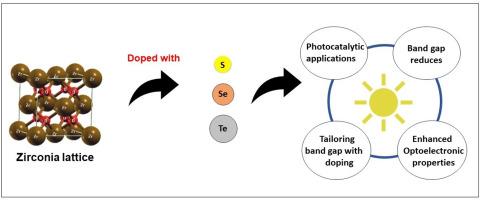Exploring the electronic properties of doped zirconia for enhanced optoelectronic applications: A quantum chemical approach
IF 4.3
3区 材料科学
Q2 CHEMISTRY, MULTIDISCIPLINARY
引用次数: 0
Abstract
Zirconia (ZrO2) is a versatile material with applications in various fields due to its exceptional mechanical strength, thermal stability, and chemical resistance. In recent years, interest has surged in utilizing doped ZrO2 as photocatalysts. This study investigates the electronic properties of ZrO2 upon doping with non-metal elements sulfur (S), selenium (Se), and tellurium (Te) using first-principle calculations. The effects of different doping concentrations on the band structure and density of states (DOS) have been examined. Calculations using GGA show significant reductions in the band gap upon doping, indicating potential for improved optoelectronic performance. Specifically, using accurate DFT + U approach we found that doping ZrO2 with 25 % S led to a band gap reduction from 5.4 eV to 1.2 eV, demonstrating promising result for photovoltaic applications. This study provides valuable insights into the electronic properties of doped ZrO2 (ZrO2-xQx, Q = S, Se and Te, x = 0.25, 0.5 and 2) paving the way for tailored applications in various technological domains.

探索掺杂氧化锆的电子特性以增强光电应用:量子化学方法
氧化锆(ZrO2)具有优异的机械强度、热稳定性和耐化学性,是一种用途广泛的材料,可应用于各个领域。近年来,人们对利用掺杂 ZrO2 作为光催化剂的兴趣激增。本研究通过第一性原理计算,研究了掺杂非金属元素硫(S)、硒(Se)和碲(Te)后 ZrO2 的电子特性。研究了不同掺杂浓度对带状结构和状态密度(DOS)的影响。使用 GGA 进行的计算显示,掺杂后的带隙显著减小,这表明有可能提高光电性能。具体地说,通过使用精确的 DFT + U 方法,我们发现 ZrO2 中掺杂 25% 的 S 会导致带隙从 5.4 eV 减小到 1.2 eV,这为光电应用带来了希望。这项研究为掺杂 ZrO2(ZrO2-xQx,Q = S、Se 和 Te,x = 0.25、0.5 和 2)的电子特性提供了宝贵的见解,为各种技术领域的定制应用铺平了道路。
本文章由计算机程序翻译,如有差异,请以英文原文为准。
求助全文
约1分钟内获得全文
求助全文
来源期刊
CiteScore
7.80
自引率
2.50%
发文量
605
审稿时长
40 days
期刊介绍:
The Journal of Physics and Chemistry of Solids is a well-established international medium for publication of archival research in condensed matter and materials sciences. Areas of interest broadly include experimental and theoretical research on electronic, magnetic, spectroscopic and structural properties as well as the statistical mechanics and thermodynamics of materials. The focus is on gaining physical and chemical insight into the properties and potential applications of condensed matter systems.
Within the broad scope of the journal, beyond regular contributions, the editors have identified submissions in the following areas of physics and chemistry of solids to be of special current interest to the journal:
Low-dimensional systems
Exotic states of quantum electron matter including topological phases
Energy conversion and storage
Interfaces, nanoparticles and catalysts.

 求助内容:
求助内容: 应助结果提醒方式:
应助结果提醒方式:


